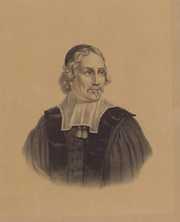Jacobus Golius

Jacob Golius (born Jacob van Gool; German: Jacob Gohl; Italian: Iacobo Golio; 1596, The Hague – September 28, 1667, Leiden), was a Dutch Orientalist and mathematician. His most important work is the Lexicon Arabico-Latinum, (Leiden, 1653), which, based on the Sihah of Al-Jauhari, was only superseded by the corresponding work of Freytag in 1837.
Life
Golius came to the University of Leiden in 1612 to study mathematics. In 1618 he registered again to study Arabic and other Eastern languages, where he was the most distinguished pupil of Erpenius. In 1622 he accompanied the Dutch embassy to Morocco, and on his return he was chosen to succeed Erpenius (May 12, 1625). In the following year he set out on a Syrian and Arabian tour from which he did not return until 1629. The remainder of his life was spent at Leiden where he held the chair of mathematics as well as that of Arabic.
Golius taught mathematics to the French philosopher René Descartes, and later corresponded with him.[1] It is therefore highly probable that he was able to read to him parts of the mathematical Arabic texts he had started to collect, among others on the Conics.[2]
Jacobus Golius played a role in convincing Europeans about the Jesuits' discovery that the mysterious Cathay, visited by Marco Polo and other travelers in the 13th century was the same country as China, reached by the Portuguese sailors in the early 16th century. Although Golius knew no Chinese, he was familiar with Zij-i Ilkhani, a work by the Persian astronomer Nasir al-Din al-Tusi, completed in 1272, in which he had described the "Cathayan" Calendar.[3] When the China-based Jesuit Martino Martini visited Leyden in 1654, the curious Golius arranged to meet him. As Golius started reciting the names of the 12 divisions into which, according to Nasir al-Din, the "Cathayans" were dividing the day, Martini, who of course knew no Persian, was able to continue the list. The names of the 24 solar terms reported by Nasir al-Din matched those that Martini had learned in China as well. The story, soon published by Martini in the "Additamentum" to his Atlas of China (Novus Atlas Sinensis), seemed to have finally convinced most Europeans scholars that China and Cathay were the same.[4]
Publications
Among his earlier publications may be mentioned editions of various Arabic texts (Proverbia quaedam Alis, imperatoris Muslemici, et Carmen Tograipoetae doctissimi, necnon dissertatio quaedam Aben Synae, 1629; and Ahmedis Arabsiadae vitae et rerum gestarum Timuri, gui vulgo Tamer, lanes dicitur, historia, 1636). In 1656 he published a new edition, with considerable additions, of the Grammatica Arabica of Erpenius. After his death, there was found among his papers a Dictionarium Persico-Latinum which was published, with additions, by Edmund Castell in his Lexicon heptaglotton (1669). Golius also edited, translated and annotated the astronomical treatise of Alfragan (Muhammedis, filii Ketiri Ferganensis, qui vulgo Alfraganus dicitur, elementa astronomica Arabice et Latine, 1669).
See also
- History of cartography
- cartography
- Ancient maps
References
 This article incorporates text from a publication now in the public domain: Chisholm, Hugh, ed. (1911). Encyclopædia Britannica (11th ed.). Cambridge University Press. The article can be seen at 1911encyclopedia.org.
This article incorporates text from a publication now in the public domain: Chisholm, Hugh, ed. (1911). Encyclopædia Britannica (11th ed.). Cambridge University Press. The article can be seen at 1911encyclopedia.org.- Bio at the Baheyeldin Dynasty site
- ↑ Sasaki, Chikara (2003). Descartes's mathematical thought. (Volume 237 of Boston studies in the philosophy of science). Springer-Verlag. pp. 3, 206–207, 222–225. ISBN 1-4020-1746-4.
- ↑ Hattab suggests that this collection was the primary reason for Descartes' choice to study with Golius: Hattab, Helen (2009), Descartes on Forms and Mechanisms, Cambridge University Press, p. 156, ISBN 9780521518925.
- ↑ van Dalen, Benno; Kennedy, E.S.; Saiyid, Mustafa K., «The Chinese-Uighur Calendar in Tusi's Zij-i Ilkhani», Zeitschrift für Geschichte der Arabisch-Islamischen Wissenschaften 11 (1997) 111–151
- ↑ Lach, Donald F.; Van Kley, Edwin J. (1994), Asia in the Making of Europe, Chicago: University of Chicago Press, ISBN 978-0-226-46734-4. Volume III, "A Century of Advance", Book Four, "East Asia", p. 1577.
|